Trichomoniasis is one of the most common sexually transmitted diseases, the causative agent of which is the simplest microorganism. The symptomatology of the pathology varies considerably: from pronounced manifestations to asymptomatic carriage. In women, the diagnosis is made after Trichomonas is detected in a smear. The urgency of the problem is due to the high likelihood of complications.
Record content:
-
1 Views
- 1.1 Spicy
- 1.2 Chronic
- 1.3 Asymptomatic carriage
- 2 Causes
- 3 Symptoms
- 4 Diagnostics and analyzes
- 5 Course of the disease and causes
- 6 In pregnant women, possible complications
- 7 Treatment
-
8 Folk remedies
- 8.1 St. John's wort
- 8.2 chamomile
- 9 Trichomoniasis video
Views
Trichomonas in a smear in women indicates an infection has taken place. Trichomoniasis is an infectious disease. The pathogen is Trichomonas vaginalis, which is a microscopic single-cell organism. It actively moves and penetrates into the intercellular space due to the membrane, which contracts in a wave-like manner, as well as special flagella.
It is an anaerobic microorganism (living without oxygen), which significantly limits its spread. It is extremely unstable in external conditions, so the probability of transmission of the disease through personal hygiene items is very small. The main route of infection is considered to be sexual contact.
In women, the pathogen is usually found:
- in the vagina;
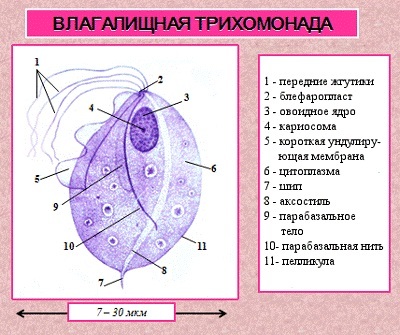
- in the bladder and urethra;
- in the Bartholin glands;
- in the cervix.
The incubation period is 1 to 10 days. The first symptoms appear between 4 and 28 days after infection. Sometimes any manifestations may be absent.
Spicy
In the acute period, the symptoms are most pronounced.
The disease manifests itself:
- copious foamy discharge (yellowish or greenish);
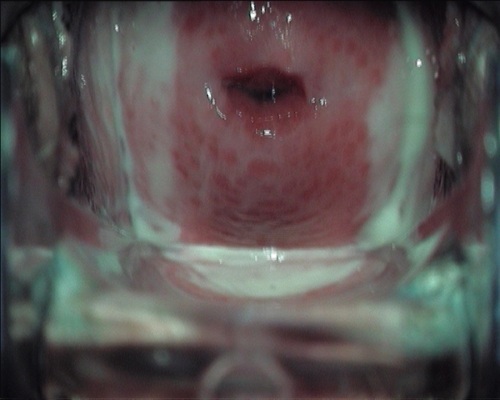
- sharp unpleasant odor;
- swelling and redness of the mucous membranes of the genital organs.
All this is often accompanied by unbearable itching, pain during urination and discomfort during intercourse.
Chronic
Without proper, timely therapy, the disease becomes chronic. Symptoms in this case become less pronounced. Chronic trichomoniasis is usually a mixed process.
Therefore, in addition to Trichomonas, the analyzes contain:
- chlamydia;
- mushrooms;
- gonococci;
- mycoplasma;
- gardnerella;
- ureaplasma.
Chronic disease is considered if more than 2 months have passed from the moment of infection.
Asymptomatic carriage
In half of cases, the symptoms of trichomoniasis in women may not be present or they are mild. The diagnosis is often made already when there are complications.
Women have Trichomonas in a smear, but clinical manifestations are absent in cases of Trichomonas carriage. Such cases pose a serious epidemiological danger, because they are not identified sources of infection.
Causes
The main cause of the disease is Trichomonas vaginalis infection. It is transmitted sexually from a sick person. Infection through personal hygiene items is unlikely.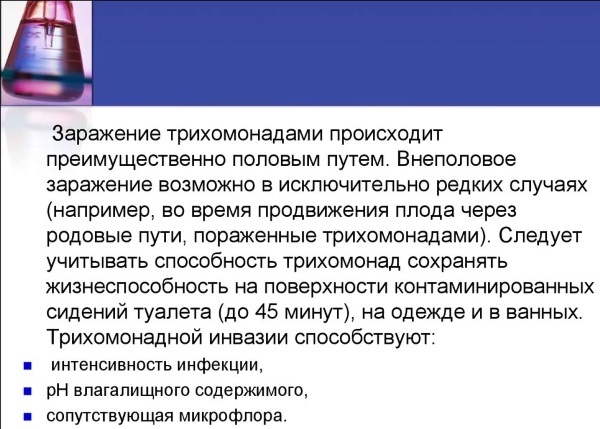

The risk of infection increases with promiscuity in the choice of sexual partners, neglect of barrier methods of contraception. It should be remembered that only the use of a condom gives a 100% guarantee.
Symptoms
Symptoms of trichomoniasis can vary significantly: from pronounced manifestations to their almost complete absence.
In the first case, women present the following complaints:
- the appearance of yellowish or greenish discharge, often having a foamy character;
- fetid odor of discharge, reminiscent of rotten fish;
- intolerable itching, irritation in the genital area;
- redness and swelling of the mucous membranes;
- soreness during intercourse and urination.
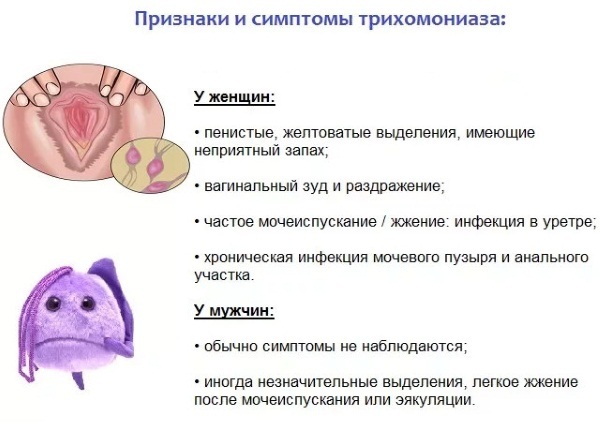
Sometimes the symptoms may be very subtle or completely absent.
When the infection spreads to the fallopian tubes, uterus, ovaries, there are pains in the lower abdomen of a pulling nature, a rise in body temperature. Trichomonas can affect the urethra, causing it to swell and redness, as well as the urinary kidney, bladder, which is manifested by the clinical picture of cystitis and pyelonephritis.
Diagnostics and analyzes
In women, the diagnosis is made on the basis of the symptoms present and the detection of Trichomonas in a smear. The symptoms of the disease are not specific, so it is impossible to make an accurate diagnosis based on them alone. Material for analysis in women is taken from the vagina, cervical canal, urethra, rectum.
They use the following methods:
- cultural;
- molecular genetic;
- microscopic;
- serological.
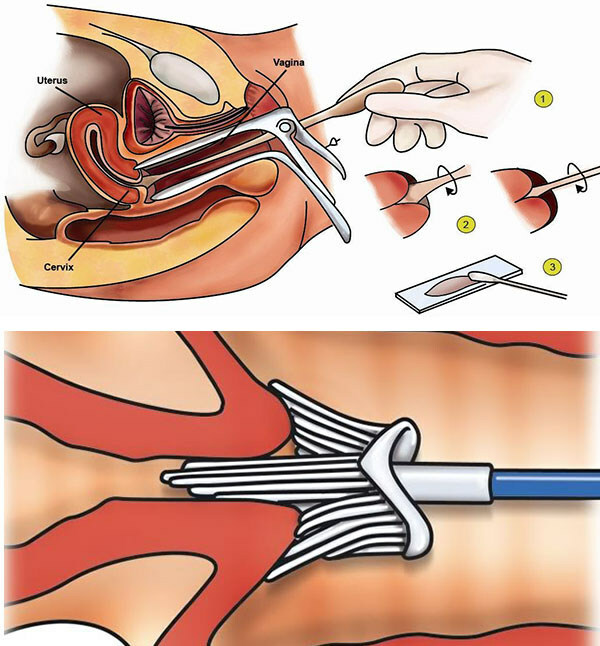
The microscopic method requires the application of the resulting material on a glass slide. Subsequently, it is studied under a microscope. Within an hour after taking the material, you can examine a native smear, otherwise called wet (not subject to staining).
In it, mobile forms of Trichomonas are found. They are well detected in the acute form of the disease. If the smear is taken later or the disease is latent, then the probability of detecting motile microorganisms is quite low.
The smears that undergo staining are more informative, because they allow you to identify cells not only by their mobility, but also by a certain shape and size.
The culture method involves placing the obtained material on a special nutrient medium. It allows you to identify the presence of Trichomonas, when the symptoms of the disease are mild or atypical.
The method is highly sensitive, but requires a long period of time. It is used both as a diagnosis of the disease and to monitor the results of the treatment.
The molecular genetic method is based on the detection of regions of RNA and DNA of the pathogen (reactions such as PCR, NASBA, and others). However, for example, PCR is less sensitive than the culture method. For this reason, it is recommended to carry out these two methods together, which significantly increases the accuracy of the study.
Serological research is only an addition to the rest of the methods. It is a blood test for the presence of antibodies to Trichomonas.
The result obtained should be assessed only in combination with other techniques - this is due to the fact that antibodies in the blood can persist for a long period of time after an infection (somewhere before of the year). The main disadvantage of this study is the high probability of false positive and false negative results.
In smears, not only Trichomonas can be found, but also other indirect signs indicating inflammation:
- a large accumulation of leukocytes;
- increased amount of mucus;
- the presence of gardnerella, yeast cells;
- coccal flora.
Microscopy of an unstained smear is performed most quickly. In this case, you can get the result within 10 minutes. The cultural method takes the most time. It takes more than a week to complete.
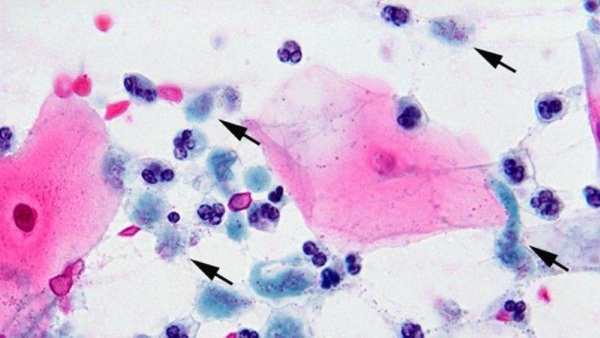
The techniques used to identify Trichomonas are clearly presented as follows:
| Microscopic | Cultural | Molecular genetic | Serological | |
| Material | Scraping | Scraping | Scraping | Blood from a vein |
| The essence | Study of the resulting material applied to a glass slide under a microscope | Sowing the material taken on nutrient media, followed by tracking the growth of pathogens on it | Determination of DNA and RNA regions of the pathogen | Detection of antibodies to Trichomonas |
| Duration | Unstained smears about 10 min. | More than a week | 1-2 business days | 1-2 business days |
| Sensitivity | In the acute stage of the disease reaches 70%, in the chronic and latent - 30-70% | 95% | 55 to 95% | High probability of false positive and false negative results |
With an integrated approach, the implementation of all recommendations for preparing for research, as well as with the correct sampling of material, the diagnosis is made most accurately.
Course of the disease and causes
The disease can be acute, subacute, chronic or asymptomatic.
The stage immediately following infection is considered acute. The inflammatory process is quite intense with pronounced manifestations. In smears, there are many Trichomonas, leukocytes, but few epithelial cells, there are no lactic acid sticks.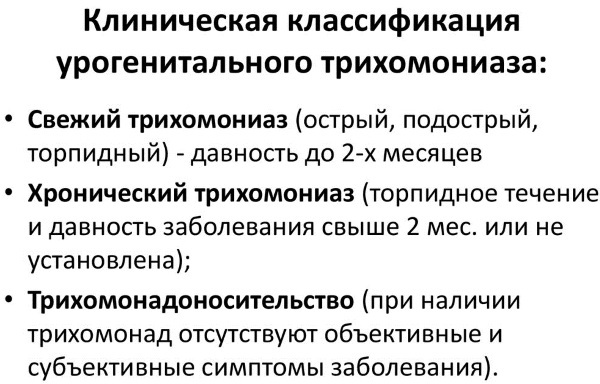
With a subacute course, the symptomatology subsides, becomes insignificant, the amount of discharge decreases.
The disease becomes chronic in the absence of adequate therapy after 2 months. after infection. For the chronic form, a wave-like course is often characteristic: the symptoms subside, then intensify again. Women notice the appearance of leucorrhoea and discomfort before or immediately after menstrual bleeding.
In chronic trichomoniasis in smears, the number of Trichomonas can either increase or decrease, epithelial cells are present in large numbers, and leukocytes, on the contrary, lactic acid sticks are not are discovered.
Trichomonas in a smear in women is found in small quantities, and epithelial cells and lactic acid sticks are not detected at all, in cases of asymptomatic course of the disease.
In pregnant women, possible complications
Trichomoniasis does not lead to the development of fetal malformations, but this disease is highly undesirable during pregnancy. The aggressive environment that forms in the vagina can negatively affect the lower walls of the amniotic fluid. This often leads to the rupture of amniotic fluid, causing premature birth or miscarriage.
In women with trichomoniasis, babies are born with low birth weight. There is also a high probability of transmission of the infection to the child during its passage through the birth canal.
 When receiving a positive test result, you must make sure that it is reliable. Metronidazole, used to treat trichomoniasis, is not recommended for use in the 1st trimester. It can be dangerous for a child and should be prescribed exclusively by an obstetrician-gynecologist, taking into account all the features of the course of pregnancy.
When receiving a positive test result, you must make sure that it is reliable. Metronidazole, used to treat trichomoniasis, is not recommended for use in the 1st trimester. It can be dangerous for a child and should be prescribed exclusively by an obstetrician-gynecologist, taking into account all the features of the course of pregnancy.
Treatment
Metronidazole is used in the treatment of trichomoniasis. It is recognized as one of the most effective against this disease. The drug acts not only on the simplest microorganisms, but also on the anaerobic microflora. It also promotes the production of interferon. To achieve the required concentration of metronidazole in the blood, it is more acceptable to take it orally (orally).
In addition to metronidazole, other 5-nitroimidazole derivatives are also used in the treatment of the disease:
- ornidazole;
- tenonitrozole;
- tinidazole;
- nimorazole.
Derivatives of nitroimidazole are quite effective in the treatment of trichomoniasis in the acute stage. However, they do not contribute to the normalization of the internal environment of the vagina.
For this purpose, vaccination with SolcoTrichovak is used. It helps to stabilize the pH of the vagina, colonize lactobacilli, and increase immunity. Such conditions become uncomfortable for the reproduction of trichomanades, which reduces the likelihood of a relapse of the disease.
It should be noted that clinical observations have reliably established that the most an effective drug is mertronidazole, the effectiveness of treatment with ornidazole lowest.
For half a century of using this group of drugs, there has been an increase in the number of strains of the pathogen with drug resistance. In this regard, the rate of recurrence of the disease is about 44-47%.
Treatment regimens are determined only by the attending physician; independent use of medications for treatment is unacceptable. Moreover, even the manufacturer in the instructions indicates that the dosage and regimen of drug use are prescribed by a doctor depending on the clinic, the condition and age of the patient, the results of laboratory research.
The following are generally accepted:
| It is prescribed mg / once a day / number of days | |||
| A drug | Typical | Alternative | Complicated and recurrent forms |
| Metronidazole | 500/2/7 | 2000/1/1 | 500/3/7 or 2000/1/5 |
| Ornidazole | 500/2/5 | 1500/1/1 | 500/2/10 |
| Tinidazole | 500/2/5 | 2000/1/1 | 2000/1/3 |
| Treatment of pregnant women not earlier than the second trimester | |||
| Metronidazole | 2000/1/1 | ||
| Treatment of children | |||
| Metronidazole | 10 mg per kg body weight / 3/5 | ||
| Ornidazole | 25 mg per kg body weight / 1/5 |
An increase in the success of treatment when combined with oral administration of local forms of drugs of the same group, as well as an increase in dosage, is a delusion. The alternative treatment option has come to the fore in recent decades, since the clinical experience of specialized clinics shows the effectiveness of the scheme and its quite sparing treatment regimen.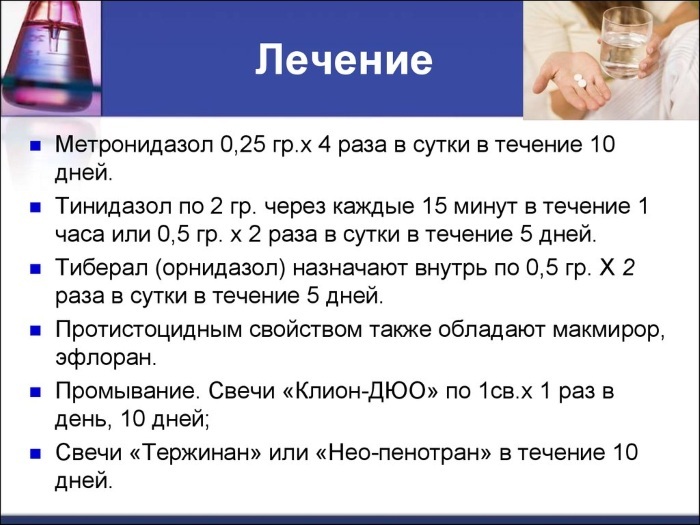
In addition, according to experts, relapses of the disease should be treated with a typical dosage. But before the second course, the patient should be treated with erythromycin or amoxicillin to reduce the number of streptococci, which reduce the effectiveness of treatment due to the capture of the nitro group.
Before starting the course of therapy, an examination for immunodeficiency should be carried out and, if any, immunomodulators should be prescribed in addition to the main treatment regimen.
The disease is considered cured if:
- Trichomonas are not detected in smears taken from the urethra, vagina, cervical canal, rectum.
- Favorable results were obtained during the next 2-3 menstrual cycles.
- There are no clinical manifestations of the disease.
For successful treatment, it is important that all sexual partners undergo it simultaneously.
Folk remedies
Folk remedies in this situation are powerless and can only be used as an adjunct to the main treatment. Many herbs have anti-inflammatory and immunomodulatory effects, and therefore promote a speedy recovery.
The following herbs can be used to prepare decoctions:
St. John's wort
One of the most famous medicinal plants. However, due to the huge number of healers and healers, in recent years, the correct recipes for folk remedies based on it have been lost. Most often, the types of funds and dosage are confused. In addition to drug therapy for trichomoniasis, a decoction of St. John's wort should be used. The preparation is very simple.

In a liter thermos, 15 g of dried raw materials are laid (no more than 3 tbsp. l. or 10 filter bags). After that, boiling water is poured into it and the thermos is sealed with a cork for 15 minutes. Then, the resulting broth should be cooled and filtered through a fine sieve or cheesecloth. Should be used for douching and applications.
In addition, it is possible to take it inside for a third of a glass 3 times a day. Before use for any purpose, it is advisable to slightly warm the broth. Prepare a new portion of the product daily. The broth should not be used for more than 2 weeks. The break in application should be at least 2 months.
chamomile
The anti-inflammatory and antispasmodic properties of chamomile are widely used. Therefore, in this case, its application is in priority. A decoction from this plant is prepared and used in the same way as St. John's wort. However, you should not take a decoction of chamomile inside, since it cannot affect the genitourinary sphere.
These two plants can be used without additional consultation with a doctor, since they have no real contraindications. Many sources recommend about a dozen more folk recipes.
However, this is done without taking into account contraindications and side effects. For example, a number of publications recommend using celandine, which in this case does not have any effect. But at the same time, the plant is extremely poisonous even when applied externally. Therefore, all folk remedies for use in gynecology and dermatovenerological practice should be prescribed only by the attending physician.
Trichomoniasis is a widespread sexually transmitted disease. Its symptomatology can be either pronounced or not manifest at all. The diagnosis in women is made on the basis of the clinical picture and the detection of Trichomonas in a smear. Self-medication of the disease is strictly prohibited, since in 90% of cases it leads to the transition of pathology to a chronic or complicated form.
Article design: Vladimir the Great
Trichomoniasis video
Malysheva about trichomoniasis:

